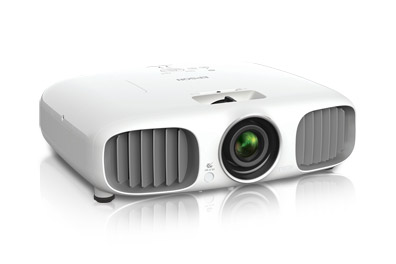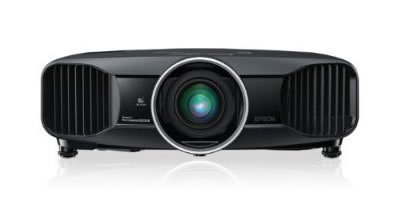|
New Epson projectors offer a bright, detailed home theater experienceBy Jim Bray If you're looking for the best, most rewarding home theater experience – and if you have the room in your home – there's nothing quite like having a front projection video system. These two piece (projector and screen) systems can offer truly stupendous screen sizes for less than a comparable flat panel TV would cost, and with the advantage that you don't have to try bending your flat panel to get it around corners or on down the staircase to your home theater room. As if you could bend a flat panel anyway! Many of the leading electronics manufacturers – such eminent names as Sony, Panasonic, JVC and others – offer such systems, but for the past several years my reference home theater projectors have come from a company you might not think of in the same sentence as the words "home theater:" Epson. I first became familiar with the Epson brand name through its printers, but when I converted from a rear projection CRT-based HDTV to a front projection system several years ago, I had the opportunity to review an Epson. It was, no pun intended, quite an eye opener and I decided right there and then to use Epsons as my reference projectors, a practice that continues today. Sure, there are better projectors, but in my experience the company's combination of performance and price is hard to beat. A really BIG show… Why go the projector route? Well, my main home theater has a 106 inch (measured diagonally) roll up screen which actually gives more than four times the viewing area of a 50 inch panel! And when it comes to watching movies or sports events, it's pretty hard to argue against an image that's about two thirds the size of the entire wall. Couple that to a kick butt audio system and there's very little incentive to shell out $15 for a movie theater ticket ever again. So while it does cost a certain amount of dough to set up your own home theater, the results can be worth it – and a dedicated home theater could even raise the value of your home. But back to Epson. I got to try a couple of the company's newest projectors recently, the Powerlite Home Cinema 3020 and the Powerlite Pro Cinema 6020UB. The 3020 retails for about $1800, while the "nearly industrial strength" 6020UB (Ultra Black) sells for a much dearer (but still inexpensive considering what you get) $3600. That isn't quite an apples-to-apples pricing comparison, however; the 6020 also ups the content ante by including a spare bulb, cable cover and full mounting kit in the box, stuff for which you'd pay extra if purchasing a lesser unit. Both projectors under discussion here feature 3D capability (including the ability to upconvert 2D to 3D, which they do with surprisingly good results) and come with two pairs of USB-rechargeable RF 3D glasses in the box. There should be at least four sets inlcuded, but what can you do? Both projectors also feature three LCD performance, which means there's a 1080p compliant LCD panel for each of the three primary colors. This isn't new – all the LCD projectors I've tried have been three LCD models – but it's the way it should be. Other features common to both projectors include split screen capabilities (in 2D mode), so you can watch two sources at once (with separate inputs, of course), five 2D color modes (two in 3D), two HDMI 1.4 inputs, component and composite video, VGA, RCA audio, and USB connections. The 3020 delivers "up to" 2,300 lumens of color and white brightness, as well as a competitive in this segment contrast ratio of 40,000:1. It also includes two built-in 10 watt speakers that I can't imagine anyone with a half decent audio system caring about. Still, the speakers do add extra flexibility and if you ever plan to use your projector for other than home theater duties (PowerPoint presentations given some place other than in your home theater, perhaps?), this unit will fit the bill. The 3020's picture modes include Dynamic, Living room, Natural, Cinema, Auto (2D) as well as 3D Dynamic, 3D Cinema. I ended up leaving it in "auto" after discovering via the HD Basics calibration disc that the picture was nigh on perfect right out of the box. I only had to make one slight adjustment, turning the brightness down one position, before it was bang on. Ditto for the 6020UB, which also adds THX certification to the mix – and the THX setting was bang on right out of the box. Most impressive! Helping facilitate installation are horizontal and vertical lens shift features that can help you align the picture to the screen if you can't get the projector mounted perfectly in front of it. There are also keystone adjustments you can make via the onscreen menu, but you shouldn't need them if your installer is any good. And of course there's generous zoom capability to tailor the projector to your screen and room size, as well as a focus ring you should only have to adjust once, Murphy's Law notwithstanding. The Pro Cinema 6020UB, being a more professionally-focused model than the 3020, boasts a truly outstanding "up to" 320,000:1 contrast ratio and "up to" 2,400 lumens of color and white brightness. And though I didn't run the two side by side, the difference is noticeable – not as much in the brightness department as in the contrast, where the 6020's incredible black levels help create the most cinematic-looking images I've seen in my home theater. I watched a variety of programming sources for this review, ranging from the best Blu-rays to SDTV and HDTV broadcasts and upconverted DVD signals. The picture quality from both projectors is exquisite – bright and crisp and colorful – and even the 3020 offers excellent black level performance, though it obviously pales next to the 6020UB's. The 6020UB also boasts "FineFrame" technology, which supposedly makes for smoother frame interpolation and sharper video quality in 2D. there's also a cinema filter for improved color fidelity – and if you really want to go high end you can add an anamorphic lens (sold separately). You can also tweak the alignment of the 6020UB's LCD panels, in kind of the same way you could adjust the conversion of the three tubes on old style, CRT-based projection systems of days gone by. This could come in really handy if you find the panels drifting sometime down the road. Adjustments are made via the remote control and the onscreen menu and it's very straightforward, though it isn't something that should be attempted by the faint of heart. I had a bit of difficulty judging the projectors' 3D performance because I have problems seeing 3D properly. What happens is that, instead of images coming out of the screen toward me, I see a 3D world that extends back from the screen, as if the screen were a window onto a 3D world beyond. To ensure a fair test, I got people whose eyes work properly to view some 3D, as well as 2D to 3D conversion, and they came away impressed. We tried such 3D titles as "Avatar," "The Polar Express" and the new release of Top Gun 3D, and we even upconverted some sports broadcasts to 3D with very intriguing results. The Epsons did a very job of keeping the picture bright and lifelike – the 6020 obviously doing a better job thanks to its higher quality innards. Both projectors adjust their picture settings to 3D automatically, then reset themselves to their 2D settings when you've finished messing around in three dimensions. I still think 3D is only a temporary fad, but the best video units these days include the capability in the price anyway, so it's there whether you want it or not. And even though I'm a 3D denier, I must admit there's something spectacular about 3D technology when you watch it on a truly gigantic screen, even if your eyes can't do it justice. Of course, you can say that about 2D movies as well I didn't try any games using these Epsons, due to some logistical problems during the review period, but if my experience playing driving games and first person shooters on older projectors is any indication, these projectors will offer highly satisfying and engrossing results. Indeed, you could say that the bigger the screen you have, the better the experience will be – whether it be movies, sports, games, or even TV (though "Jeopardy!" doesn't benefit much!). Of course, your projector has to be up to snuff for that to be true; fortunately, both of these Epsons are. I was also impressed with the projectors' lack of "judder," an LCD phenomenon that leads to a bit of a jerky, kind of blurred picture when the camera moves – especially, it seems, in a side-to-side pan. It can be quite annoying and, though neither of these projectors gets rid of the effect completely, it was reduced to the extent that it wasn't particularly bothersome. Epson estimates bulb life for both models as up to 5000 hours in "eco" mode, which dims the picture appreciably compared to the "rape the environment" setting and its up to 4000 hours of bulb life. I preferred the brighter setting, but it also means the fan noise is a lot more obtrusive. Fortunately, it was easy to drown out the fan by cranking the audio system… Obviously, I liked both of these projectors a lot. In fact, since it was time to upgrade my home theater anyway, after my review sessions were over I decided to put my money where my mouth is (which must have looked pretty funny!) and went down to my local Epson retailer, Calgary's K & W Audio, and ordered a 6020UB, which now graces my home theater and will act as my reference projector for the next few years at least. And I expect it to serve me extremely well. I would have purchased the 3020, and undoubtedly been perfectly happy with it, but I made the mistake of trying the 6020UB, which is superior enough to justify spending twice as much – though that isn't really an apples-to-apples price comparison considering that the 6020UB also comes with a spare bulb, ceiling mounting kit, and "cable hiding system." In other words, it's a bargain! Sure, you can get better projectors, but you'd have to look long and hard to beat these Epsons for the price of entry. They are simply excellent. Copyright 2013 Jim Bray Jim Bray's columns are available through the TechnoFile Syndicate. We welcome your comments! |
|
|||||



